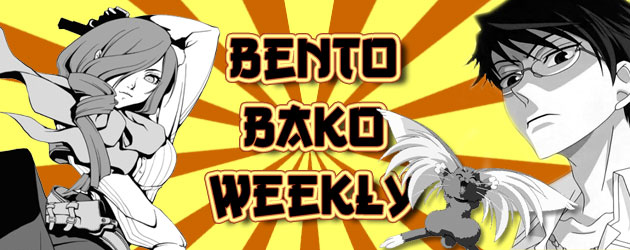 Bakuman
Bakuman
Author: Story by Tsugumi Ohba, art by Takeshi Obata
Publisher: Viz Media (Shonen Jump)
Volume: Volume 3 (ongoing), $9.99
Vintage: 2009 by Shueisha, February 2011 (out now) by Viz Media
Genre: Slice of life, comedy
This one will probably go quickly. There aren’t a lot of story points to discuss, and everything is pretty straight forward. Moritaka Mashiro and Akito Takagi are working hard to create a popular manga to fulfill their dream. Mashiro has made a deal with the girl he likes, Miho, to get married once they’re dreams come true. Mashiro will draw a hit manga and get it made into an anime, so that Miho, who wants to be a voice actress, can voice the lead heroine. That’s essentially the entire plot of the series. Volume 3 sees the two young men struggling to come up with a story that meets their editor’s approval. Their editor continually tells them that they should try and make something unique to them, but the boys insist on creating a mainstream battle manga, thinking it will be the quickest rise to popularity. They spend time calculating out every detail of the plot to appeal to the widest audience possible, drawing ideas from other popular battle manga titles. But time and again, their editor turns them down, telling them that something is missing, that their story is impersonal and doesn’t stand out. Takagi gets stuck in a rut; none of his ideas are meeting with Mashiro or their editor’s approval, and he can’t seem to come up with a story that really clicks. To give Takagi a break, Mashiro decides to become an assistant to Eiji Nizuma, the young artist who was recently given his own series and is their biggest current rival. The eccentric Nizuma, defying his editor and his publisher, decides he doesn’t want to draw the story he has been contracted to, and reverts back to the story which won him the award that led to getting his own series. Mashiro, awed by Nizuma’s speed and talent, believes he can learn something, a trick or some idea he can steal, by working with Nizuma. The pressure is on, as Miho has scored a role in a late night anime, though it’s only a bit part. The publicity around the show has made her an overnight sensation on the Internet, and Mashiro worries he won’t be able to catch up to her fast enough. As Takagi continues to struggle with developing an idea, he begins to hang out with his girlfriend Miyoshi more, which rattles Mashiro’s trust in his friend, as he believes Takagi is hanging out with Miyoshi rather than working on his story. In the end, they both come up with a new idea, but it’s very different than what they each were supposed to be working on. Their partnership shaken over summer break, will the two continue to work together, or branch out on their own?
Many thanks to David’s review of this volume over at Manga Bookshelf for really getting my brain going over this one. Though it really only served to confuse me more. I really don’t get this series. It’s advertised like it’s supposed to be a serious (well, serious for a comedy) look inside the manga industry, but at the same time, it seems to be poking fun at everything. Are we supposed to be taking it seriously (and are they getting away with it because of who they are, and all the “product placement” in the series), or are Ohba and Obata really pulling one over on us and making fun of their own profession? Or is it just meant to be fantastical from the get go? The characters really do sit there and plot their entire manga around the most popular elements of the most popular manga. Saying things like, “we need this in there, and that in there,” all so they can appeal to the widest audience. I can’t really begrudge them that, but their entire drive is simply to be popular. It’s no wonder they can’t come up with anything good. I really hope Ohba and Obata aren’t saying they (or anyone else for that matter) really create manga this way. But then I see this line from Mashiro, as they’re trying to come up with a heroine, and Miyoshi suggests she helps them as a female herself: “It’s a boys’ manga, so we just need to come up with a boy’s idealization of a girl.” My jaw dropped, because that describes Miho perfectly. I’ve seen many bloggers complain about Miho, and that is an issue they continue going back to. That she’s simply an idealization, a male fantasy. So, again…are they making fun of themselves here? Or is this truly what Ohba and Obata think? Then there’s Nizuma, an annoying, troublesome child, a newcomer, who breaks his contract by writing a story other than the one he has been contracted to do. Why isn’t he fired? This kid must be spectacular, because he’s a brand new creator without a published series, the story he was supposed to be writing has already been advertised, and he’s immature and constantly defies his editor (though thankfully he changes his attitude later). Maybe I’m just getting too caught up in something that is only fiction anyway. I just wish I knew how I was supposed to read Bakuman. Because one way I’m very irritated by it, but another way I might find it amusing.
 Dorohedoro vol 3
Dorohedoro vol 3
Author: Q Hayashida
Publisher: Viz Media (Sig IKKI)
Volume: Volume 3 (ongoing), $12.99
Vintage: 2002 by Shogakukan, January 2011 by Viz Media
Genre: Action, cyberpunk, fantasy
Caiman, a large man with the head of a lizard, has been hunting down his memories, an encounter with a sorcerer having caused a bout of amnesia, as well as the loss of his original head. His partner, Nikaido, helps him hunt down sorcerers who enter their world in hopes of finding the one who attacked him. In the world of Dorohedoro, Caiman and Nikaido live in the Hole, a world where non-magic users live. The world of the magic users is filled with sorcerers who have bargained with devils for their powers, a bargain designated by a unique mask that they always wear. These sorcerers frequently journey to the Hole to practice their magic, which takes the form of dark smoke, and conduct experiments. In the magic world lives En, a powerful man who runs his own company, with a menagerie of bodyguards and other employees at his disposal. Among these employees are Shin and Noi, to powerful magic users who do all of En’s dirty work. Tagging along is the less powerful Fujita, whose partner was recently killed by Caiman. As of volume 3, he is accompanied by a girl named Ebisu, whom he rescued from Caiman, but who was traumatized by the event.
In volume 3, En, Noi, Shin, and Ebisu attend a party for high-powered magic users. En hopes to make a certain special guest his new partner. This sorcerer can supposedly reanimate dead bodies, a rare power that En desires. As Shin and Noi head off to eliminate her current partner, Ebisu is recognized by another sorcerer, who slips her some black powder, a magic enhancing drug used by weaker sorcerers, causing a sudden explosion of power. Meanwhile, Shin and Noi successfully capture the resurrectionist, but unfortunately, she is a black powder user, and En angrily destroys her with his mushroom magic. Left behind is the true source of her power, a small goat-like creature that En takes home instead. En plans to have the creature reanimate the head from Caiman’s mouth so they can find out who the sorcerer was that changed him. Meanwhile, Caiman and Nikaido continue their own journey by paying a visit to a sorcerer researcher, in hopes of finding a doorway into the sorcerers’ world. As Caiman and Nikaido wonder the magic world, back at En’s the head starts to awaken. Caiman and Nikaido follow a man with similar eye markings to Caiman, but unfortunately it leads them to a building where Noi and Shin have been given a job. The entire group is wiped out by the time Caiman arrives. As Nikaido runs around town collecting resources and information, En attempts to get information out of the head calling itself Risu. Unfortunately, if Risu knows anything, he’s not willing to talk, and puts on a clueless idiot act. En’s interrogation is interrupted as Nikaido infiltrates his home and starts causing mayhem. En, angered by Nikaido’s assault, unleashes his powers on friend and foe alike. A bonus chapter follows Ebisu as she attempts to wiggle into En’s family, jealous of the “family portraits” hanging on En’s walls.
I liked this one better the second time I read through it, but overall it doesn’t resonate with me, though I couldn’t really tell you why. The concept is pretty unique, and the art is very detailed and fitting for the setting. There are even a handful of really nice color pages. The mythology doesn’t have a lot of depth, unless there’s more to it that hasn’t been revealed. It’s a simple and straight forward story, though that doesn’t mean it isn’t complex. There are plenty of secrets tucked away, such as Ebisu’s true identity and the identity of the man who cursed Caiman. We know that Nikaido is a sorcerer, but not why she chooses not to use her magic. We know that Fujita isn’t entirely useless, like he appears, because he has exhibited amazing power on rare occasions. There are fifteen volumes in Japan currently, so there’s clearly a lot more story to tell. There are two whole worlds to explore, filled with their own unique characters and culture. If you’re looking for something different, it’s worth a look. You can currently preview the first chapter of each volume at Sig IKKI.
Editor’s Note: ComicAttack.net has been pre-nominated for an Eagle Award! Please click hereto vote for us in the “Favorite Comic Book Website” category (question #27). Thank you for your continued support!
Kris
kristin@comicattack.net
@girlg33k_Kris
Review copies provided by Viz Media.


Pingback: Manga Village relocates, maid cafes under the microscope « MangaBlog
Pingback: Bento Bako Bonus: Bakuman 4, Gente 3
Pingback: Bento Bako Weekly: Dorohedoro Vol 4
Pingback: Bento Bako Weekly: Dorohedoro Vol 4 – ComicAttack.net